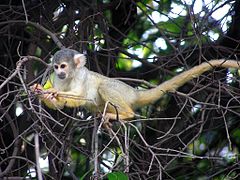|
Sajmiri
Sajmiri
| Saimiriinae
|
| G.S. Miller, 1912[1]
|
|
|

Przedstawiciel podrodziny – sajmiri czarnołbista (S. boliviensis)
|
| Systematyka
|
| Domena
|
eukarionty
|
| Królestwo
|
zwierzęta
|
| Typ
|
strunowce
|
| Podtyp
|
kręgowce
|
| Gromada
|
ssaki
|
| Podgromada
|
żyworodne
|
| Infragromada
|
łożyskowce
|
| Rząd
|
naczelne
|
| Podrząd
|
wyższe naczelne
|
| Infrarząd
|
małpokształtne
|
| Rodzina
|
płaksowate
|
| Podrodzina
|
sajmiri
|
| Typ nomenklatoryczny
|
|
Simia sciurea Linnaeus, 1758
|
| Synonimy
|
- Chrysotrichinae[a] Cabrera, 1900[2]
- Saimiridae G.S. Miller, 1912[1]
- Chrysothricinæ: Anthony & Coupin, 1931[3]
- Saimiriinae: Hershkovitz, 1974[4]
- Saimiriini: Rosenberger, 1981[5]
- Saimirinae: H. Schneider, M.P.C. Schneider, Sampaio, Harada, Stanhope, Czelusniak & M. Goodman, 1993[6]
|
|
| Rodzaje
|
|
2 rodzaje (w tym 1 wymarły) – zobacz opis w tekście
|
|
|
|
Sajmiri[7] (Saimiriinae) – podrodzina ssaków naczelnych z rodziny płaksowatych (Cebidae).
Zasięg występowania
Podrodzina obejmuje gatunki występujące w Ameryce Środkowej i Południowej[8][9][10].
Morfologia
Długość ciała 22–42 cm, ogona 33–47 cm; masa ciała 550–1400 g[10].
Systematyka
Podział systematyczny
Do podrodziny należy jeden występujący współcześnie rodzaj[11][8][7]:
Opisano również rodzaj wymarły[12]:
- Neosaimiri Stirton, 1951 – jedynym przedstawicielem był Neosaimiri fieldsi Stirton, 1951.
Uwagi
- ↑ Typ nomenklatoryczny: Chrysothrix Kaup, 1835 (= Saimiri Voigt, 1831).
Przypisy
- ↑ a b G.S. Miller. List of North American land mammals in the United States National Museum, 1911. „Bulletin - United States National Museum”. 79, s. 379, 1912. (ang.).
- ↑ A. Cabrera. Estudios sobre una colleción de monos americanos. „Anales de la Sociedad Española de Historia Natural”. Serie II. 9 (29), s. 67, 1900. (hiszp.).
- ↑ R. Anthony & P. Coupin. Tableau résumé ́d’une classification générique des Primates fossiles et actuels. „Bulletin du Museum national d’histoire naturelle”. 2e série. 3, s. 569, 1931. (fr.).
- ↑ P. Hershkovitz. A new genus of Late Oligocene monkey (Cebidae, Platyrrhini) with notes on postorbital closure and platyrrhine evolution. „Folia Primatologica”. 21 (1), s. 26, 1974. DOI: 10.1159/000155594. (ang.).
- ↑ A.L. Rosenberger: Systematics: the higher taxa. W: A.F. Coimbra-Filho & R. Mitermeier (redaktorzy): Ecology and behavior of neotropical Primates. Cz. 1. Rio de Janeiro: Academia Brasileira de Ciencias, 1981, s. 9–27. (ang.).
- ↑ H. Schneider, M.P.C. Schneider, I. Sampaio, M.L. Harada, M.J. Stanhope, J. Czelusniak & M. Goodman. Molecular phylogeny of the New World monkeys (Platyrrhini, Primates). „Molecular Phylogenetics and Evolution”. 2 (3), s. 235, 1993. DOI: 10.1006/mpev.1993.1022. (ang.).
- ↑ a b Nazwy polskie za: W. Cichocki, A. Ważna, J. Cichocki, E. Rajska-Jurgiel, A. Jasiński & W. Bogdanowicz: Polskie nazewnictwo ssaków świata. Warszawa: Muzeum i Instytut Zoologii PAN, 2015, s. 39. ISBN 978-83-88147-15-9. (pol. • ang.).
- ↑ a b C.J. Burgin, D.E. Wilson, R.A. Mittermeier, A.B. Rylands, T.E. Lacher & W. Sechrest: Illustrated Checklist of the Mammals of the World. Cz. 1: Monotremata to Rodentia. Barcelona: Lynx Edicions, 2020, s. 186. ISBN 978-84-16728-34-3. (ang.).
- ↑ D.E. Wilson & D.M. Reeder (redaktorzy): Subfamily Saimiriinae. [w:] Mammal Species of the World. A Taxonomic and Geographic Reference (Wyd. 3) [on-line]. Johns Hopkins University Press, 2005. [dostęp 2020-11-05].
- ↑ a b Rylands i in. 2013 ↓, s. 391–396.
- ↑ N. Upham, C. Burgin, J. Widness, M. Becker, C. Parker, S. Liphardt, I. Rochon & D. Huckaby: Treeview of Mammalian Taxonomy Hierarchy. [w:] ASM Mammal Diversity Database (Version 1.11) [on-line]. American Society of Mammalogists. [dostęp 2023-09-13]. (ang.).
- ↑ R.A. Stirton. Ceboid monkeys from the Miocene of Colombia. „University of California Publications, Bulletin of the Department of Geological Sciences”. 28 (11), s. 326, 1951. (ang.).
Bibliografia
- A.B. Rylands, R.A. Mittermeier, B.M. Bezerra, F.P. Paim & H.L. Queiroz: Family Cebidae (Squirrel Monkeys and Capuchins). W: R.A. Mittermeier, A.B. Rylands & D.E. Wilson (redaktorzy): Handbook of the Mammals of the World. Cz. 3: Primates. Barcelona: Lynx Edicions, 2013, s. 348–413. ISBN 978-84-96553-89-7. (ang.).
Identyfikatory zewnętrzne ( takson): |
|